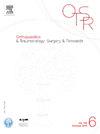Conversion of hip resurfacing to total hip arthroplasty: is the outcome closer to primary or revision total hip arthroplasty?
IF 2.3
3区 医学
Q2 ORTHOPEDICS
引用次数: 0
Abstract
Background
Along with the advent of newer bearings, hip resurfacing (HR) is gaining renewed interest as a bone sparing alternative to conventional total hip arthroplasty (THA) in young patients. However, the outcome of conversion of failed HR to THA (HRc) remains sparsely described. This study aimed to compare the outcomes and complication rates of HRc to those of primary (pTHA) and revision THA (rTHA) to find out to which group HRc is most comparable.
Hypothesis
The study hypothesis was that the outcomes and complications rates of HRc were closer to those of pTHA than rTHA.
Materials and methods
Between 2001 and 2011, a continuous series of 207 HR were prospectively included in our institutional registry and retrospectively analyzed. Out of them, 17 HR (8%) were converted to THA. Propensity scores were used to match patients in the HRc group to the pTHA and the rTHA groups using a greedy 1:3 matching procedure (51 pTHA and 51 rTHA). Clinical and radiographic outcomes, perioperative data and complications were analyzed and compared between the three groups.
Results
No significant difference between HRc and pTHA was observed in terms of clinical and functional outcomes, duration of surgery, acetabular component diameter and length of hospital stay (p = 0.13 to 0.94). Perioperative blood loss was significantly lower for pTHA than for HRc (p = 0.01). HRc demonstrated significantly higher HHS and HOOS scores than for rTHA at one year (p = 0.03 and p < 0.01, respectively). Duration of surgery was significantly lower in HRc compared to rTHA (p = 0.02) while length of hospital stay was similar (p = 0.84). Complication rate was significantly higher in the rTHA group, compared to HRc and pTHA groups (37.3 vs. 29.4 vs. 11.8%, p = 0.01).
Conclusion
This study demonstrated that the clinical and functional outcomes of HRc were closer to those of pTHA than those of rTHA, though complication rate was higher than for pTHA.
Level of evidence
III; Retrospective comparative study
髋关节置换术转为全髋关节置换术:结果更接近于初次还是翻修全髋关节置换术?
背景:随着新型轴承的出现,髋关节置换术(HR)作为年轻患者传统全髋关节置换术(THA)的一种保留骨量的替代方法,再次受到人们的关注。然而,关于髋关节置换术失败后转为全髋关节置换术(HRc)的结果描述仍然很少。本研究旨在比较HRc与初治(pTHA)和翻修THA(rTHA)的疗效和并发症发生率,以找出HRc与哪一组疗效和并发症发生率最接近:研究假设:与rTHA相比,HRc的疗效和并发症发生率更接近于pTHA:2001年至2011年期间,我院登记并回顾性分析了207例连续性HR。其中,17 例 HR(8%)转为 THA。采用倾向评分法将HRc组患者与pTHA组和rTHA组患者进行匹配,匹配程序为贪婪1:3(51例pTHA和51例rTHA)。对三组患者的临床和影像学结果、围手术期数据和并发症进行了分析和比较:结果:在临床和功能预后、手术时间、髋臼组件直径和住院时间方面,HRc和pTHA无明显差异(p = 0.13至0.94)。pTHA 的围手术期失血量明显低于 HRc(p = 0.01)。一年后,HRc 的 HHS 和 HOOS 评分明显高于 rTHA(p = 0.03 和 p 结论:本研究表明,与rTHA相比,HRc的临床和功能结果更接近于pTHA,但并发症发生率高于pTHA:证据等级:III;回顾性比较研究。
本文章由计算机程序翻译,如有差异,请以英文原文为准。
求助全文
约1分钟内获得全文
求助全文
来源期刊
CiteScore
5.10
自引率
26.10%
发文量
329
审稿时长
12.5 weeks
期刊介绍:
Orthopaedics & Traumatology: Surgery & Research (OTSR) publishes original scientific work in English related to all domains of orthopaedics. Original articles, Reviews, Technical notes and Concise follow-up of a former OTSR study are published in English in electronic form only and indexed in the main international databases.

 求助内容:
求助内容: 应助结果提醒方式:
应助结果提醒方式:


